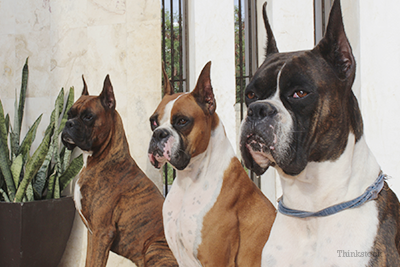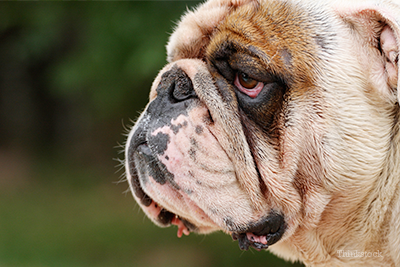AJ Debiasse, a technician in Stroudsburg, PA, contributed to this article.
It's no secret that a large percentage of the population has become obsessed with visual appearance. In response, the plastic surgery industry has grown significantly, not only in the US but in South Korea as well. However, a recent article published on Korean news site Chosun Ilbo and commented on in English by Kotaku.com (a member of the Gawker network of sites) reveals that this applies to dogs in South Korea as well. In the last few days, several writers have picked up the story, often declaiming the practice.
 Your reaction may be similar to my initial feeling when hearing about this: Why would anyone put their dog through plastic surgery? Aren't some of their imperfections what make them so cute? Have we gone too far and can this be humane? But when I actually read the article, I was not as outraged as I thought I would be… because several of the practices discussed are ones still being requested and performed here in the U.S.
Your reaction may be similar to my initial feeling when hearing about this: Why would anyone put their dog through plastic surgery? Aren't some of their imperfections what make them so cute? Have we gone too far and can this be humane? But when I actually read the article, I was not as outraged as I thought I would be… because several of the practices discussed are ones still being requested and performed here in the U.S.
All judgments aside, here are some quick facts:
Tail-Shortening (or "Docking")
One cosmetic procedure mentioned in the South Korean article is tail shortening. Despite the official position of the AVMA (American Veterinary Medical Association), tail docking remains a common procedure for many dog breeds in the US. The procedure is usually done when the puppy is just days old.
Ear Trimming (or "Cropping")
Another plastic surgery mentioned in the Korean article is ear trimming, to make the ears pointier, like you might see on Doberman Pinschers. Again, ear cropping is done in many breeds to achieve the American-standard “look” and, if performed, is routinely done at a young age. This surgery gives the classic "tough" look found in breeds such as boxers, pit bull-type dogs and others.
Mixed Veterinary Opinions In the US
While both of these procedures are legal and performed in the United States, the AVMA states that it “opposes ear cropping and tail docking of dogs when solely for cosmetic purposes. The AVMA encourages the elimination of ear cropping and tail docking from breed standards". In many countries outside of the US, ear cropping and tail docking are completely banned, along with declaws on cats (which we will save for another time).
 Can Elective Surgery Have Medical Reasons?
Can Elective Surgery Have Medical Reasons?
Another cosmetic procedure mentioned in the South Korean article is double eyelid surgery. It is difficult to tell from the article if the goal is to change the shape of the eyes for purely cosmetic reasons, or if they are talking about correcting a medical condition. There are two surgical procedures that are medically warranted when the eyelids are not shaped correctly. Cats and dogs can have an eyelid that rolls in (entropion) or out (ectropion). Other conditions that may be treated surgically include what’s commonly known as cherry eye.
With entropion, the eyelids roll inward and the eyelashes rub against the eye, causing irritation and pain. Breeds often affected include Shar Peis, Chow Chows, Bulldogs, Retrievers, Rotties, Setters etc.
On the opposite, with ectropion, the edge of the eyelid rolls out. Its inner lining, or conjunctiva, appears red. Constant exposure causes irritation (conjunctivitis) or even infection. Common breeds include Bloodhounds, Mastiffs, Great Danes, Newfies, St. Bernards etc.
Mixed Veterinary Opinions in South Korea
Other procedures mentioned in the Korean article are much more questionable: “straightening wrinkles,” “removal of stomach stretch marks,” “removal of fat” and Botox. Now this might be a whole different story since none of these procedures has an obvious medical basis. However, not all South Korean veterinarians agree that performing these procedures should be allowed.
Yes, one anonymous veterinarian is quoted saying: “Plastic surgery for pets in the past were for medical reasons, but the result also brought better looking dogs, so there is a growing customer base getting a plastic surgery for cosmetic reasons on their dogs.”
Another vet, Dr. Yoon, told the journalist that plastic surgery was “medically safe” in dogs and that it was “the owner’s right” to make their pet beautiful.
Yet this does not represent every Korean vet’s feelings. According to a survey in a Korean veterinary magazine, 63% of respondents believe that cosmetic surgery for dogs should be banned.
Clearly, there are vast differences from culture to culture in the level of pet care and the sense of ethics. Although anesthesia is generally speaking very safe, it does come with risk. It can be difficult for some patients to recover from. (Find out 10 questions to ask before your dog or cat’s surgery) For me, if surgery does not cure a medical condition or improve quality of life, it's difficult to justify any procedure where the only goals are to alter the way a dog looks and please the dog owner.
Overall, some procedures mentioned in the Korean article are medically indicated. Others, like doggie Botox, remain highly controversial.
So tell us: What do you think about cosmetic surgery for pets?
If you have any questions or concerns, you should always visit or call your veterinarian -- they are your best resource to ensure the health and well-being of your pets.
